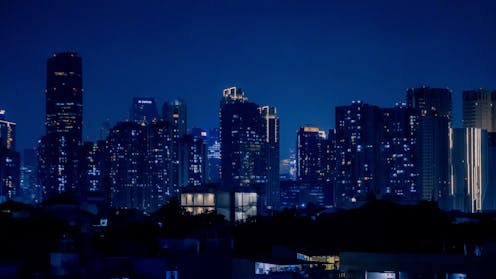‘Darkening’ cities is as important for wildlife as greening them
Nighttime in Jakarta, Indonesia. Akhnaffauzi/Shutterstock
For billions of years, life has depended on Earth’s rhythm of day and night. DNA codifies body clocks in all animals and plants, which helps their cells act according to this cycle of light and dark.
Humans have disrupted this cycle, though, by producing artificial light at night. A growing body of scientific evidence shows this can have negative effects on many different forms of life.
Essentially, artificial light at night changes the sensory capacities of living things. It can disturb the magnetic orientation of migratory birds and beguile insects, causing them to become easier prey and exhausting them. The same disruption to body clocks we see in wildlife is also linked to health consequences in people.
Drawn like moths to the flame…
Livio Federspiel/Shutterstock
Apart from some caves, deserts and deep-sea trenches, most of Earth has been invaded by light pollution to some degree, or is under threat of its encroachment. In 2001, astronomer Pierantonio Cinzano and colleagues created the first global atlas of light pollution. It calculated that two-thirds of the world’s population lived in areas where nights were at least 10% brighter than natural darkness.
The scale of the problem was updated in 2016 when the team renewed their atlas. By that time, 83% of people globally were living under a light-polluted sky – and 99% in the UK, Europe and North America.
The situation is not improving: too much light in the wrong place or at the wrong time causes big problems. But restoring darkness can help mitigate some of these issues – and cities are a good place to start.
Alternative urban illumination
Light is widely associated with safety, security and surveillance, but it does not necessarily deter crime. A 2019 study in Melbourne, Australia, for example, showed that more lighting alone did not create safer urban spaces.
Many people are familiar with the idea of greening cities by planting more street trees. If we were to darken cities, we would benefit biodiversity – and the health and wellbeing of humans and nonhumans too. The responsible use of lighting should be decided by an ethical and aesthetic argument for how we want cities after dark to be.
Read more:
Cities need to embrace the darkness of the night sky – here’s why
In my latest book, Dark Futures, I argue that cities should not necessarily seek to create areas of natural darkness with no artificial light – but rather, try to make urban areas navigable at night without harming wildlife. The question is where and when to have illumination, and how it should be deployed and controlled.
Look to the Bahnstadt district of Heidelberg in Germany for an approach that ensures a dark environment for wildlife. Here, infrared sensors have been fitted along a 3.5km cycle path that keeps lights dimmed when not in use.
Likewise, in Lille’s Parc de la Citadelle, France, a nocturnal corridor has been created to preserve biodiversity after dark. Each lighting unit along the path through the park consists of three LEDs with different settings. The brightest lights are only activated when pedestrians, cyclists and cars are detected by sensors.
The brightness of the lighting also mimics natural light patterns throughout the year. This approach, known as biophilic lighting, aligns artificial lighting with seasonal changes.
There have also been efforts to protect particular species at night. Bat-friendly lighting in the Dutch town of Zuidhoek-Nieuwkoop involves streetlamps emitting a red colour and using a wavelength that doesn’t interfere with a bat’s internal compass. The scheme still provides enough illumination for people.
Other forms of lighting, such as bioluminescence, could alter or even replace streetlamps as we know them. Bioluminescence is the emission of light by a chemical reaction in certain organisms.
To date, this type of illumination has only been applied in small experiments, such as those in the town of Rambouillet, France. Here, light is produced by a marine bacterium inside saltwater-filled tubes: a mix of basic nutrients feeds the bacteria, which glow in response. These “lights” are turned off again by stopping airflow into the tubes, putting the bacteria into a dormant state.
Unlike traditional streetlamps, they do not need to be connected to the electricity grid, and their intensity is never sufficient to disturb wildlife. This could open new avenues for the design of urban illumination – which is important, as we need new options.
Cities at night are ideal laboratories to responsibly explore our relationships with light and dark – for the benefit not only of people, but the countless species we share Earth with.
Don’t have time to read about climate change as much as you’d like?
Get a weekly roundup in your inbox instead. Every Wednesday, The Conversation’s environment editor writes Imagine, a short email that goes a little deeper into just one climate issue. Join the 45,000+ readers who’ve subscribed so far.
Nick Dunn is affiliated with the advocacy group DarkSky UK.



